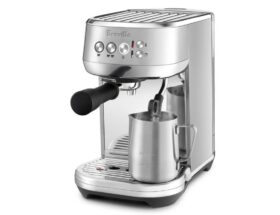
How to Reduce Coffee Acidity: Tips for a Low Acid Coffee
Are you a coffee lover who often finds yourself grappling with stomach issues after indulging in a cup of joe? You’re not alone. Many people experience discomfort and acidity after drinking coffee. However, there’s good news – you don’t have to give up your beloved cup of coffee. In this guide, we’ll explore tips and tricks to reduce coffee acidity, allowing you to enjoy a low acid brew without compromising on flavor. So, grab a mug and let’s dive into the world of low acid coffee!
Welcome to our blog post on reducing coffee acidity and enjoying a low-acid cup of coffee. In this article, we will provide you with expert tips and strategies to help you minimize the acidity and acid reflux with your favorite brew.
Whether you have a sensitive stomach or simply prefer a milder coffee flavor, we’ve got you covered. Keep reading to discover the secrets behind creating a low acid coffee without compromising on taste or aroma.
Table of Contents
Tips for Reducing Coffee Acidity
1. Choose Low Acid Coffee Beans
One of the easiest ways to reduce the acidity in your coffee is by choosing low acid coffee beans. Look for coffee beans that are specifically labeled as “low acid” or “less acidic.” These beans are often grown in regions with lower altitude and have been specially processed to remove some of the acidity. By opting for low acid coffee beans, you can enjoy a smoother and less acidic cup of coffee.
2. Opt for Cold Brew
If you’re a true coffee lover but struggle with acid reflux or sensitive stomach, cold brew coffee might be your savior. Cold brewing coffee reduces its acidity significantly compared to hot brewing methods. The slow extraction process of cold brew results in a rich and smooth cup of coffee with lower acidity. Give it a try and see the difference it makes for your taste buds and digestive system.
3. Add a Pinch of Salt
Believe it or not, adding a pinch of salt to your coffee can help neutralize some of its acidity. The salt works by counteracting the bitter and acidic flavors, making your coffee taste smoother. Just be cautious not to add too much salt, as it can overpower the natural flavors of the coffee. Start with a small pinch and adjust according to your taste preferences.
4. Use a Coarser Grind
The grind size of your coffee beans plays a crucial role in the overall acidity of your brew. Finely ground coffee tends to extract more acidic compounds, resulting in a more acidic cup. To reduce acidity, opt for a coarser grind size. This slows down the extraction process, giving you a milder and less acidic coffee. Experiment with different grind sizes to find the perfect balance for your taste buds.
5. Cut Back on Brewing Time
If you’re using a traditional brewing method like drip coffee or a French press, reducing the brewing time can help decrease the acidity. The longer the coffee sits in contact with hot water, the more acidic it becomes. Try brewing your coffee for slightly shorter durations to achieve a smoother, less acidic cup. Keep in mind that adjusting the brewing time might require some trial and error to find the sweet spot.
6. Consider Adding Milk or Cream
If you enjoy a creamy coffee experience, adding a splash of milk or cream can also help reduce the perceived acidity. The proteins in dairy products bind to acidic compounds, thus neutralizing their effects. The fat content in milk or cream can also provide a smoother mouthfeel, making the coffee appear less acidic. Experiment with different milk options and proportions until you find the perfect balance for your taste buds.
- Choose low acid coffee beans
- Opt for cold brew
- Add a pinch of salt
- Use a coarser grind
- Cut back on brewing time
- Consider adding milk or cream
Supporting Evidence and Examples
Let’s delve deeper into the topic of reducing coffee acidity and explore some evidence-backed tips that will help you enjoy a low acid coffee without compromising on flavor.
The Science Behind Coffee Acidity
Before we jump into the tips, let’s understand why some coffees are more acidic than others. Coffee beans naturally contain acids such as chlorogenic acid, citric acid, and quinic acid. These compounds can contribute to the tangy or sour taste that some people associate with high acidity in coffee. However, it’s important to note that acidity is not the same as pH level, and high acidity doesn’t necessarily mean a low pH. Understanding this distinction will help us approach the acidity issue from multiple angles.
1. Opt for Dark Roasts
Dark roast coffees are known to have lower acidity levels compared to lighter roasts. The extended roasting process breaks down a significant amount of the acids present in the beans, resulting in a smoother and less acidic cup of coffee. So, if you’re looking to reduce acidity, consider reaching for a bag of dark roast beans or opting for a dark roast option at your favorite coffee shop.
2. Cold Brewing for a smoother cup
Cold brewing coffee has gained popularity in recent years, and for a good reason. This method involves steeping coffee grounds in cold water for an extended period (usually around 12-24 hours), which extracts the flavors without extracting the acids as much. The result is a smoother and less acidic coffee that is perfect for those with sensitive stomachs or acid reflux issues. Give cold brewing a try and notice the difference it makes in reducing acidity.
3. Choosing coffee origins with lower acidity
Another approach to reduce coffee acidity is to explore different coffee origins. Coffee beans grown in certain regions such as Brazil, Sumatra, or Guatemala tend to have naturally lower acidity levels. This can be attributed to factors like soil composition, altitude, and bean variety. By opting for coffee beans from these regions, you can enjoy a less acidic cup of joe without compromising on flavor.
4. Add Milk or Cream
If you prefer a creamy cup of coffee, adding milk or cream can also help mitigate acidity. The proteins in dairy products can bind to the acids and neutralize their impact on your taste buds. This not only reduces the perceived acidity but also adds a smooth and velvety texture to your coffee experience.
5. Try Low Acid Coffee Beans or Blends
Lastly, if you’re particularly sensitive to acidity or have been advised to limit your intake, consider exploring specialized low acid coffee beans or blends. These options are specifically processed to reduce acidity while maintaining the flavor profiles that coffee lovers enjoy. Look for brands that prioritize low acid levels in their product descriptions or seek recommendations from coffee enthusiasts who have found success with this approach.
By incorporating these evidence-based tips, you can enjoy a low acid coffee that suits your taste preferences and keeps potential stomach issues at bay.
Tips and Recommendations
- Choose a coffee with lower acidity: Opt for coffee beans that are known to be naturally low in acidity, such as Brazilian, Sumatran, or Colombian beans. Read the product descriptions or ask your local barista for recommendations.
- Try cold brew coffee: Cold brew coffee is typically less acidic than hot brewed coffee. This is because the cold brewing process extracts fewer acidic compounds from the beans. Consider making your own cold brew at home or look for cold brew options at your favorite coffee shops.
- Go for dark roasts: Dark roasted coffee beans tend to have lower acidity compared to lighter roasts. The longer roasting process breaks down more of the coffee’s acids, resulting in a smoother and less acidic flavor profile. Experiment with different roast levels to find the one that suits your taste buds.
- Consider using a coffee additive: There are a variety of coffee additives available on the market that claim to reduce acidity levels. These additives can include ingredients like potassium carbonate or calcium carbonate, which help neutralize acids. Follow the instructions provided for the specific product you choose.
- Use a coffee brewing method with lower acidity: Certain brewing methods, such as using a French press or using a coffee sock, can result in a less acidic cup of coffee. These methods typically allow more oils and compounds to remain in the final brew, resulting in a smoother taste. Experiment with different brewing techniques to find your preferred low acid method.
- Consider decaf coffee: If you find that regular coffee is too acidic for your liking, try switching to decaffeinated coffee. Decaf coffee is typically less acidic since the decaffeination process removes some of the acidic compounds. Look for decaf options labeled as “swiss water process,” as this method is known to yield particularly smooth and low acid coffee.
- Pair your coffee with food: If you enjoy coffee with your breakfast or snacks, consider pairing it with foods that can help balance the acidity. For example, having a slice of whole-grain toast or a banana with your coffee can help reduce the impact of acidity on your stomach.
By following these tips and recommendations, you can enjoy a delicious cup of low acid coffee without compromising on flavor. Experiment with different options to find what works best for your taste buds and make your coffee experience more enjoyable!
Frequently Asked Questions
1. What causes acidity in coffee?
The acidity in coffee is primarily caused by organic acids naturally present in the beans. These acids contribute to the bright and tangy flavors commonly associated with coffee.
2. How can I reduce the acidity in my coffee?
There are several ways to reduce the acidity in your coffee:
- Opt for a coffee with lower acidity: Look for beans from regions known for producing low-acid coffees, such as Brazil, Sumatra, or Guatemala.
- Use a dark roast: Darker roasts tend to have lower acidity compared to lighter roasts.
Choose a cold brew: Cold brewing coffee results in a smoother and less acidic cup.
3. Does adding milk reduce the acidity in coffee?
Yes, adding milk or cream to your coffee can help neutralize some of the acidity and provide a smoother taste.
4. Can I use baking soda to reduce coffee acidity?
Yes, adding a pinch of baking soda to your coffee grounds before brewing can help neutralize some of the acidity. However, be cautious not to use too much as it may alter the taste of your coffee.
5. Are there low acid coffee options available?
Absolutely! There are various low acid coffee options available in the market. Look for brands or specific blends that specifically mention “low acid” or “gentle on the stomach.” These coffees are often specially roasted to minimize acidity.
6. Can I still enjoy flavorful coffee with low acidity?
Definitely! While reducing acidity may slightly alter the flavor profile, there are many delicious and flavorful low acid coffee options to explore. Experiment with different brands, blends, and brewing methods to find the perfect balance for your taste buds.
Conclusion
In conclusion, reducing coffee acidity can greatly enhance your coffee drinking experience, especially if you have a sensitive stomach or dental health concerns. By following these tips and techniques mentioned above, you can enjoy a low acid coffee without compromising on flavor or aroma.
Remember to choose beans that are naturally low in acidity, such as those from Brazil or Sumatra, and opt for a darker roast. Experiment with different brewing methods like cold brew or the French press, as these can also help reduce acidity.
Furthermore, pay attention to your own body’s response to different coffee blends and brewing techniques. Everyone’s taste buds and tolerance levels vary, so be open to trying new things and adjusting accordingly.
At Ten Coffees, we are committed to exploring the world of coffee and sharing our insights and experiences with coffee lovers like you. We invite you to share your thoughts, tips, and favorite low acid coffee recommendations in the comments section below. Let’s continue the conversation and discover the perfect cup of coffee together!








